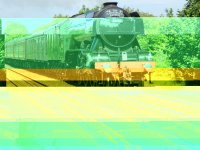Thanks for the insight..............................I might have a look at raw. at the moment I'll stick with jpg as I like to get everything right before I get the shot, I believe the image should be as is, with perhaps only cropping.
To add to what others have said on believing "the image should be as is".
I'm not entirely sure what you mean by this, but...
The way camera sensors record light doesn't match the way the human eyes sees light. To make it more complicated, the way the human eye/brain "sees" colour doesn't match the way the human brain "remembers" colour. And, to further complicate things, every individual sees light (colour, saturation and contrast) differently and there are cultural and geographical variation in the way people see/remember colours. In general we remember colours as brighter, more saturated, contrastier and warmer than they really were.
With out of the camera JEPGs the camera is using the same raw data, saved in a raw file, to create the in-camera JPEG. Generally, there is no attempt by the camera manufacturers to create JPEGs with scientifically "accurate" colour, saturation or contrast because that isn't what human beings see or remember.
In contrast, technologists and psychologists work on getting the in-camera processing to create visually pleasing results based on how some sort of "average" human being" remembers" colours, But as humans we all remember colours differently, we subjectively "like" some colour representations better than others (even if they are obviously unrealistic) and cameras allow for this by offering a choice of how the JPEGs are processed (styles/presets/emulations).
If you like one of the JPEG styles offered by your camera then that's fine, but if you want photographs that give an accurate representation of "what you saw/remember" in terms of colour, sharpness and contrast , then you need to save as a raw, and do you own processing.
The raw file only contains numbers and you can't "see" a raw file as an image. When raw files are opened in a raw processor like lightroom, the raw processor creates a jpeg from the raw data so you can see what an image of the data looks like. At this stage, just as with the JPEG straight out the camera, you are seeing the "pleasing" colours that have been decided by the people who make the software. And, as with the camera, you can choose different presets/style (some which might match those offered by your camera) to get the colours, contrast. saturation you like best.
The advantage of using RAW is that you still have all the data collected by the camera available to create the colours you want. Starting with a JPEG from the camera some of that data is lost and this affects how much you can manipulate the colours. This might restrict you being able to get colours that match the colours you saw/remember.
There are of course other things, e.g the characteristics of the screen you are viewing the picture on, or if you are looking at prints the colour and brightness of the light illuminating them, will affect the colour people see.
For most people this isn't something to get all that bothered about, because there are so many variables that affect how colour is seen. However, if you are fussy and want to feel that the colours in your picture match the colours you remember seeing (rather than the colours the camera manufacturer thinks you want to see) then you probably need to use raw files and take control of how the colour looks.



